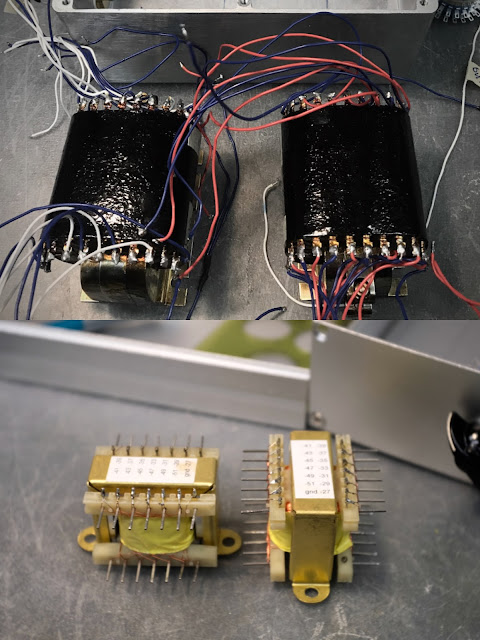Finemet FM-ATVR1 AVC
I wired this Finemet Autoformer Volume Control (AVC) from Japan for a friend of a friend in 2018. Inserted between the output of my preamp and amp or as a passive attenuator for line level sources (CD/DAC, FM Tuner, etc), I noticed the fine qualities an AVC could offer. It definitely sounds better than a passive preamp employing a volume control or resistive ladder attenuator because an autoformer turns voltage into current whereas in the latter, voltage is merely dissipated as heat. IMHO, this is why passive volume control/ladder attenuators sound mellow but lack dynamics; and short cables are required, because of their inherent high output impedance.
Due to many other projects I had lined up, I kept the AVC idea in the back burner. Besides, the cost of a pair of these Finemet FM-ATVR1 AVC was, and still is, staggering!
Five years later, the owner got tired of the dual switching arrangement. So I rewired and rehoused the Finemet AVC pair, Redboy-style. 😉
Testing the rewired/rehoused Finemet FM-ATVR1 AVC
Sinatra via FM-ATVR1
Intact Audio 28-step Nickel AVC
This unit which contains a pair of Intact Audio 28-step Ni-AVCs was also sent for repairs due to a couple of broken connections giving me an opportunity to compare them!
Finemet vs. Nickel
After several months of extensive listening comparisons between the Finemet and the Nickel, I decided that I need a pair of dave slagle's 28-step Ni-AVCs as additional tools to enjoy music. They possess the tonality I cherish in my nickel/permalloy Tamura F7002s in my SE2A3 amp and Tango NY15Ss in my SE300B mono blocks.
 |
| Under $10 Chinese 2x24 vs. over $100 Swiss Elma 2x24 position switch |
Even if the unit I repaired was equipped with an ELMA + fancy OFHC wiring, I couldn't justify the expense. So I started with the cheap Chinese clone above + silicone insulated 24 gauge tinned stranded wire from Amazon. Honestly, I can't hear a difference between my budget build vs. the boutique parts version I repaired.
Wiring a pair of AVCs may seem daunting. However, once the input and output legs of the AVC as well as their corresponding taps in the rotary switch are identified, wiring becomes routine. But admittedly, it's still a tedious task! Since my rotary switch only has 24 steps, 4 taps from the 28-step AVC were left unused. I chose to skip the first 4 even numbered taps from full attenuation.
Because of the relatively low input Z of autoformers, they require sources with low Z out - at least 1k Ohms or lower*. My RCA derived octal phono and the Lar mod Shure M65 don't work with AVCs. But my Loctal EAR834P had no problems driving it because of its 7N7 (loctal equivalent of the 6SN7) cathode follower + 1uf output cap. The standalone octal based tube phono preamps that are featured in my AVC videos are forthcoming uploads.
For more technical info about autoformers, visit Intact Audio's FAQs.
*Addendum: A veteran DIYer internet friend has successfully used source components with a 3k Ohm output Z. Perhaps my 1k Ohm guesstimate errs on the conservative side.







The “Slagelformers” are great. They were a paradigm shift for my system. Do you know anything about the Shure M66 passive phono preamp? It uses two sut’s. It outputs at mic level.
ReplyDeleteThis is the second inquiry I received regarding the Shure M66 in the past couple of days. Unfortunately I don't have experience with this device.
DeleteI received my Sowter 9335 and Intact AVC about 3 years ago, but never found the time to integrate them into the system.)
ReplyDeleteThanks for this little review. Now I have an incentive to do it faster.
Hopefully this year I can compare them.
I'm glad the article served as an inspiration. Enjoy!
DeleteThanks for the articles and experimentation. Your system sounds beautiful alive and uncompressed on the less than perfect youtube clips. I have been wanting to experiment with a Dave Slagel AVC for a while now on my Elekit amplifier which uses a TKD volume potentiometer. Would you say that an AVC should greatly improve the dynamics and detail, based on your experience? And as the amp only has one input which switch selector would to recommend if I went for one of Dave's AVC modukes?
DeleteThanks for the kind words! That said, I don't encourage people to base their decisions on my YouTube video uploads because there are just so many variables and I still believe in old school actual listening experience. My videos are merely "proof of concept as I already mentioned in my "about info" there.
DeleteMy first paragraph above addresses your question with a technical explanation. I have nothing more to add.
For an audio selector box, I use an old dB systems kit I assembled back in the 80s. A similar box was sold by Radio Shack, part no. 42-2110. I use one in my other set up. I'm sure eBay and/or Amazon carry something similar to the Radio Shack unit as well as a more audiophile oriented alternative using boutique parts.